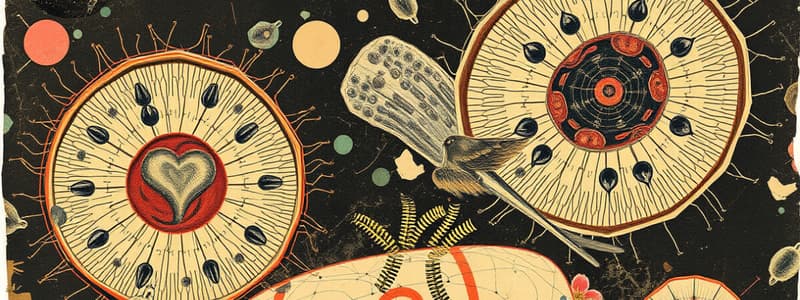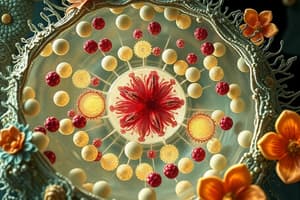Podcast
Questions and Answers
What is the function of the cell membrane?
What is the function of the cell membrane?
- Holds the cell together (correct)
- Contains DNA
- Where respiration takes place
- Makes proteins
What does the nucleus contain?
What does the nucleus contain?
DNA
What is the cytoplasm?
What is the cytoplasm?
A thick, watery solution
Where are proteins made in the cell?
Where are proteins made in the cell?
What is the purpose of mitochondria?
What is the purpose of mitochondria?
The cell wall is present in both plant and animal cells.
The cell wall is present in both plant and animal cells.
What is the function of a vacuole?
What is the function of a vacuole?
What substance do chloroplasts contain?
What substance do chloroplasts contain?
Which of these organelles are only found in plant cells?
Which of these organelles are only found in plant cells?
Multiple vacuoles are only in plant cells.
Multiple vacuoles are only in plant cells.
What shape do animal cells typically have?
What shape do animal cells typically have?
What shape do plant cells typically have?
What shape do plant cells typically have?
What molecule carries genetic information?
What molecule carries genetic information?
What is chlorophyll's role in photosynthesis?
What is chlorophyll's role in photosynthesis?
Flashcards are hidden until you start studying
Study Notes
Plant and Animal Cells Key Features
- Cell Membrane: Semi-permeable barrier; maintains cell structure and regulates material movement in and out.
- Nucleus: The cell's control center; houses DNA and regulates cellular activities.
- Cytoplasm: Viscous fluid that fills the cell, where various cellular processes occur.
- Ribosomes: Site of protein synthesis; can be found freely in the cytoplasm or attached to the endoplasmic reticulum.
- Mitochondria: Known as the "powerhouse" of the cell; responsible for aerobic respiration, converting glucose into usable energy.
- Cell Wall: A rigid layer composed of cellulose, providing strength and structure; unique to plant cells.
- Vacuole: Membrane-bound space filled with sugars and minerals; serves as the cell's storage compartment.
- Chloroplast: Contains chlorophyll for photosynthesis; only found in plant cells.
Genetic Material and Energy
- DNA: Molecule that encodes genetic information essential for growth, development, and function.
- Chlorophyll: Pigment in chloroplasts that captures light energy for photosynthesis; critical for plant energy conversion.
Differences Between Plant and Animal Cells
- Plant Cells: Characterized by a square shape, cell wall, chloroplasts, and a large central vacuole.
- Animal Cells: Typically round in shape; contain multiple small vacuoles instead of a large central one.
Studying That Suits You
Use AI to generate personalized quizzes and flashcards to suit your learning preferences.




